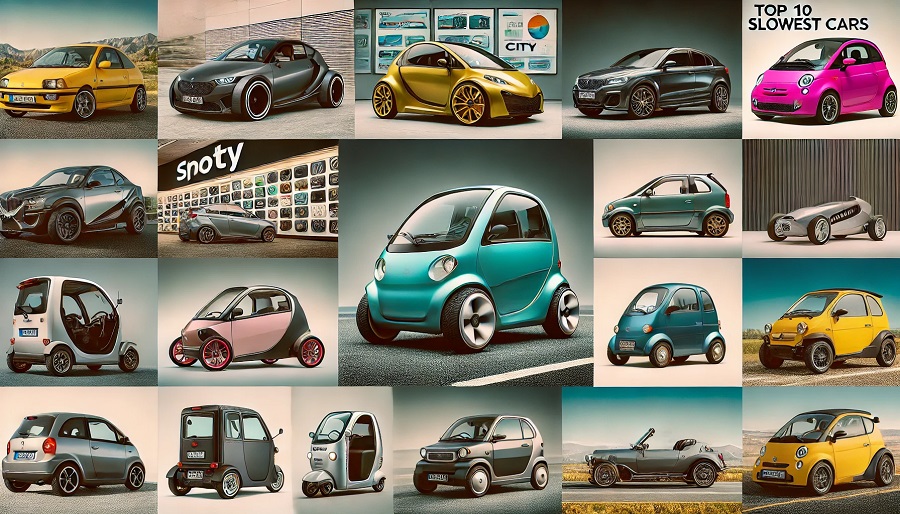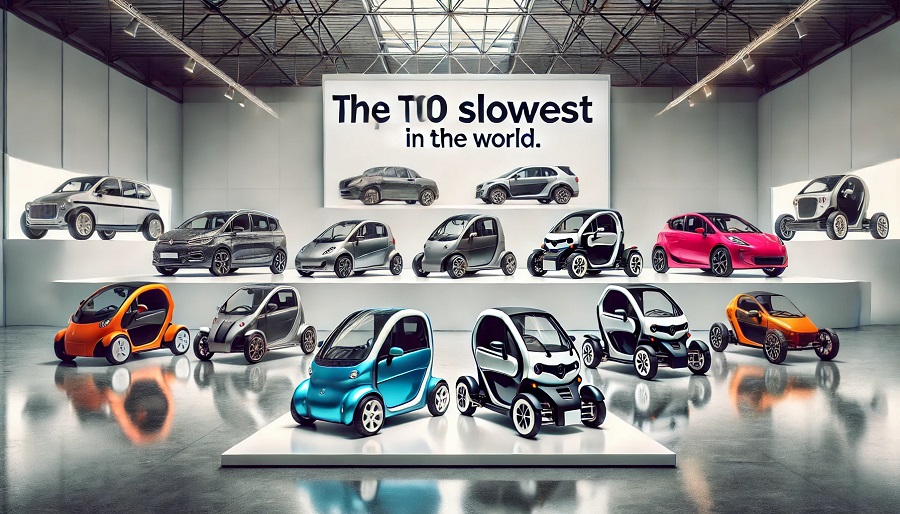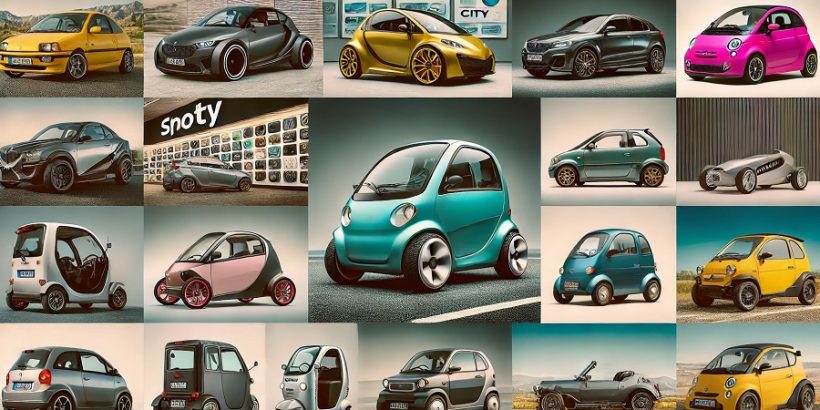When we think of cars, speed is often the first thing that comes to mind. From sleek supercars to powerful muscle cars, the automotive world is filled with vehicles designed to go fast. But what about the other end of the spectrum? What about the cars that are slow, yet still hold a special place in automotive history? In this article, we’ll take a look at the top 10 slowest cars in the world. These vehicles may not win any races, but they have their own unique charm and significance. Whether you’re a car enthusiast or just curious, this list will give you a fascinating glimpse into the world of slow-moving automobiles.

Top 10 Slowest Cars in the World
1. Peel P50 (1962-1965)
Top Speed: 38 mph (61 km/h)
The Peel P50 holds the Guinness World Record for the smallest car ever made. This microcar, produced on the Isle of Man, is a three-wheeled vehicle that measures just 54 inches long and 39 inches wide. With a top speed of only 38 mph, it’s not built for speed but for practicality. The P50 was designed for short commutes in crowded urban areas, and its lightweight design makes it easy to maneuver. Despite its slow speed, the Peel P50 has become a cult classic and is highly sought after by collectors.
2. Tata Nano (2008-2018)
Top Speed: 65 mph (105 km/h)
The Tata Nano was marketed as the “world’s cheapest car” and was designed to provide an affordable transportation solution for families in India. While it was revolutionary in terms of price, its performance was far from impressive. The Nano’s 624cc engine produces just 37 horsepower, resulting in a sluggish acceleration and a top speed of 65 mph. Despite its limitations, the Nano played a significant role in making car ownership accessible to millions of people.
3. Citroën 2CV (1948-1990)
Top Speed: 60 mph (97 km/h)
The Citroën 2CV, also known as the “Deux Chevaux,” was designed to be a simple, affordable car for French farmers. Its 375cc engine initially produced just 9 horsepower, giving it a top speed of 60 mph. The 2CV was never meant to be fast; it was built for durability and practicality. Its quirky design and slow speed have made it an enduring symbol of post-war Europe, and it remains a beloved classic car today.
4. Isetta (1955-1962)
Top Speed: 53 mph (85 km/h)
The Isetta, often referred to as the “bubble car,” is one of the most iconic microcars of all time. Its unique design features a single front door that doubles as the car’s entrance. Powered by a 236cc engine, the Isetta has a top speed of just 53 mph. Despite its slow speed, the Isetta was a popular choice for urban commuters in the 1950s and 1960s, thanks to its compact size and fuel efficiency.
5. Reliant Robin (1973-2001)
Top Speed: 85 mph (137 km/h)
The Reliant Robin is a three-wheeled vehicle that has become infamous for its tendency to tip over during sharp turns. While its top speed of 85 mph might seem decent, its lightweight design and unstable handling make it one of the slowest and most unpredictable cars on the road. Despite its flaws, the Reliant Robin has a dedicated fan base and is often featured in comedy shows and movies.
6. AMC Gremlin (1970-1978)
Top Speed: 75 mph (121 km/h)
The AMC Gremlin was a compact car that gained a reputation for being underpowered and slow. Its base model came with a 199cc engine that produced just 128 horsepower, resulting in a top speed of 75 mph. While the Gremlin was marketed as an affordable and practical car, its lackluster performance made it a target of criticism. Despite this, the Gremlin has become a nostalgic symbol of 1970s automotive design.
7. Trabant 601 (1964-1990)
Top Speed: 62 mph (100 km/h)
The Trabant 601, produced in East Germany, was one of the most common cars in the Eastern Bloc during the Cold War. Its two-stroke engine produced just 26 horsepower, giving it a top speed of 62 mph. The Trabant was known for its poor build quality and slow performance, but it was also a symbol of resilience and ingenuity in a time of scarcity. Today, the Trabant is a nostalgic reminder of a bygone era.
8. Morris Minor (1948-1971)
Top Speed: 64 mph (103 km/h)
The Morris Minor was one of the most popular British cars of the 20th century. Its 918cc engine produced just 27 horsepower, resulting in a top speed of 64 mph. While it was never designed to be fast, the Morris Minor was praised for its reliability and practicality. Its timeless design and slow speed have made it a beloved classic car among enthusiasts.
9. Fiat 500 (1957-1975)
Top Speed: 59 mph (95 km/h)
The original Fiat 500, also known as the “Cinquecento,” was a small, affordable car designed for Italian families. Its 479cc engine produced just 13 horsepower, giving it a top speed of 59 mph. Despite its slow speed, the Fiat 500 was a huge success and became a symbol of Italy’s post-war economic recovery. Its retro design has inspired modern versions of the Fiat 500, which are much faster but still pay homage to the original.
10. Volkswagen Beetle (1938-2003)
Top Speed: 68 mph (109 km/h)
The Volkswagen Beetle, or “Bug,” is one of the most iconic cars in automotive history. Its air-cooled, rear-mounted engine produced just 25 horsepower in its early models, resulting in a top speed of 68 mph. While it was never designed for speed, the Beetle was praised for its durability and simplicity. Its timeless design and cultural significance have made it a beloved classic car around the world.

Why Slow Cars Matter
While the cars on this list may not be fast, they each have a unique story to tell. From the Peel P50’s record-breaking size to the Trabant’s Cold War legacy, these vehicles have played important roles in automotive history. Slow cars remind us that speed isn’t everything—sometimes, it’s about practicality, affordability, and innovation. Whether you’re a car enthusiast or just curious, these slow-moving vehicles offer a fascinating glimpse into the diverse world of automobiles.
Final Thoughts
The top 10 slowest cars in the world may not be the most exciting vehicles on the road, but they have left an indelible mark on automotive history. From microcars like the Peel P50 and Isetta to iconic models like the Volkswagen Beetle and Citroën 2CV, these slow-moving vehicles have captured the hearts of millions. Whether you’re a fan of classic cars or just looking for a unique conversation starter, these slow cars are sure to leave a lasting impression.
So, the next time you see a slow car on the road, take a moment to appreciate its history and significance. After all, not every car is built for speed—some are built for the journey.
